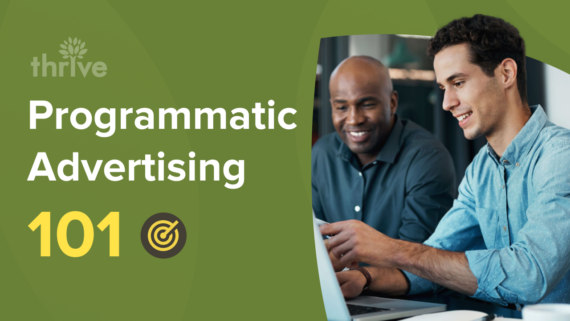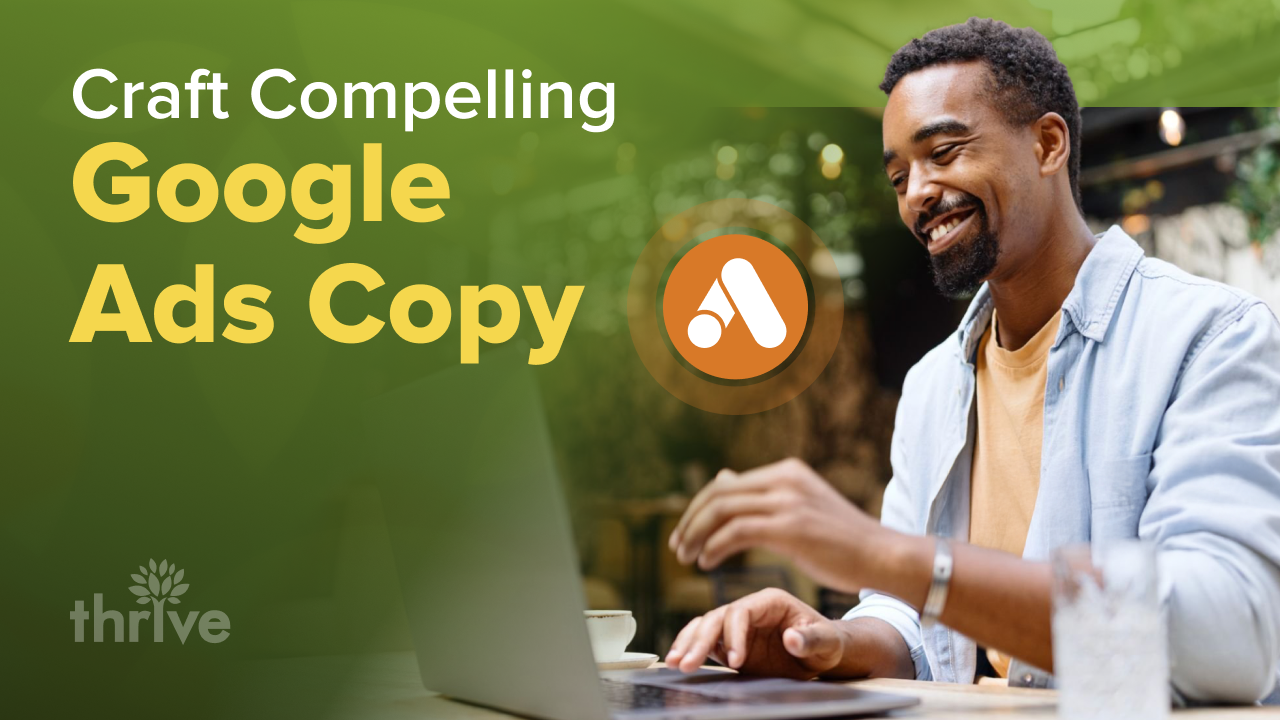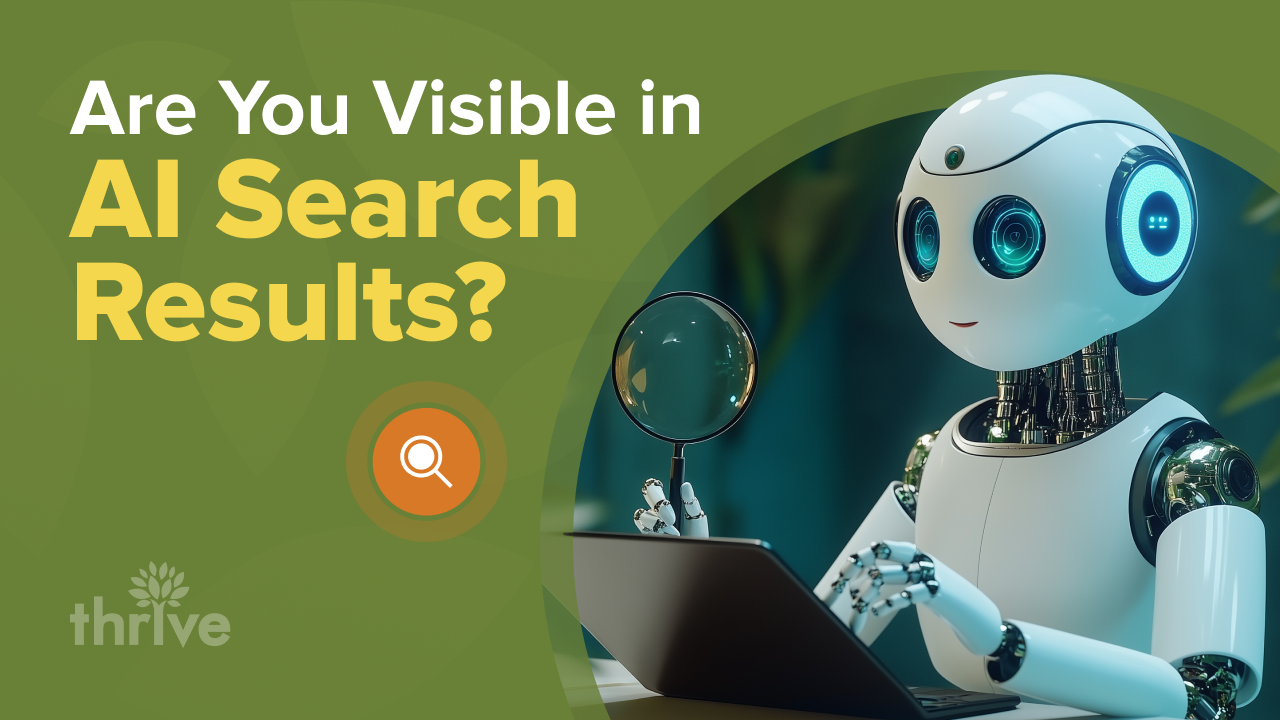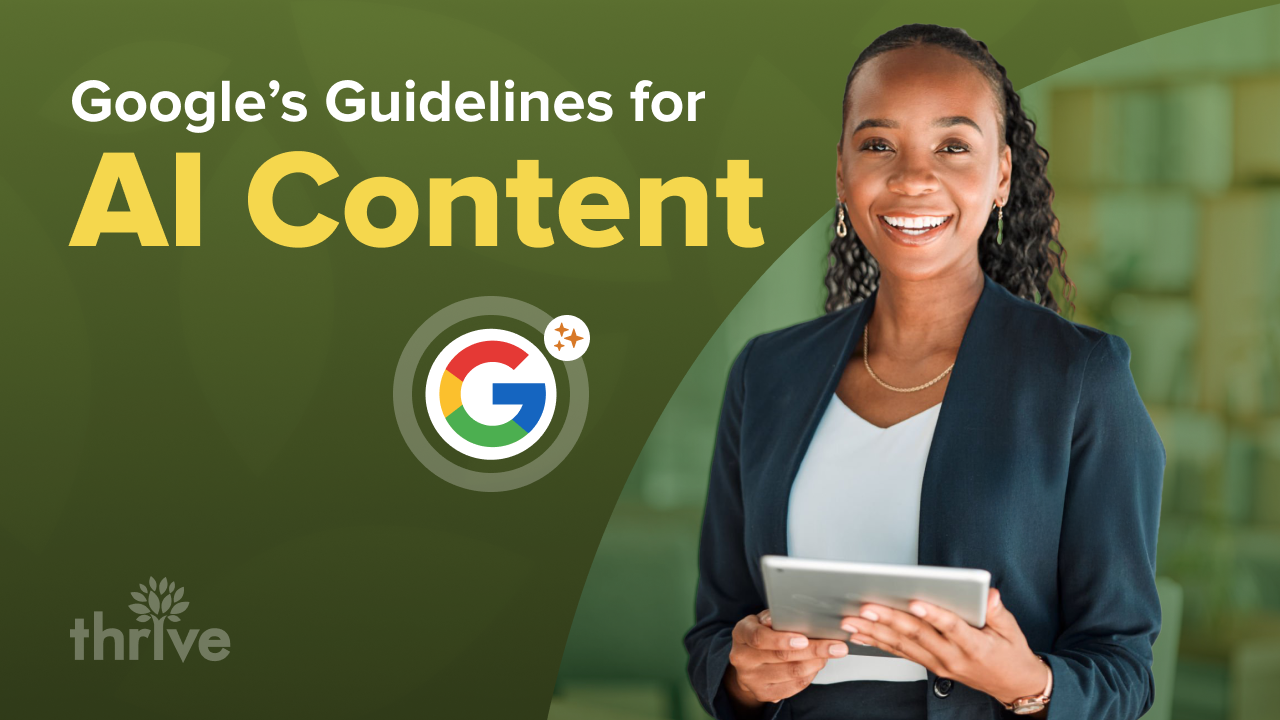Do you ever wonder how website owners manage to provide a plethora of free content online while keeping their operations afloat?
The answer could be programmatic advertising – a digital marketing buzzword that remains obscure for some. As users enjoy unparalleled access to content across a myriad of platforms, brands make a profit through programmatic advertising.
But what is programmatic advertising exactly, and how different is it from traditional advertising?
Programmatic advertising allows the delivery of immersive ad experiences that seamlessly connect both users and advertisers on their preferred devices or platforms.
Let’s talk more about all things programmatic advertising in this blog as we delve into:
• What Is Programmatic Advertising?
• Programmatic vs Display Ads
• How Programmatic Advertising Works
• Programmatic Advertising Key Terms
• Programmatic Advertising in Action
• Benefits of Programmatic Advertising: Why Programmatic Advertising Gets Results
• Types of Programmatic Media Buying (Programmatic Deals)
• Common Programmatic Ad Formats
• Top Demand-Side Platform Examples
• Top Supply-Side Platform Examples
• Programmatic Advertising Frequently Asked Questions
• Explore a New Revenue Stream With a Programmatic Advertising Agency
What Is Programmatic Advertising?
Programmatic advertising is the automated buying and selling of digital ad placements on websites, apps and even connected TV (CTV). Its use of automation spares advertisers from extensive negotiations, bidding, contracts and proposals that come with traditional advertising.
Through machine learning and artificial intelligence (AI), programmatic advertising analyzes countless user signals, including demographic data and shopping patterns.
Programmatic advertising allows advertisers to serve the right ads to the right users in the right place, at the right time and the right price.
But is programmatic advertising for everyone?
“Programmatic advertising can be fitted to any business’s marketing resources and needs,” said Cuyler Franzke, Thrive’s resident programmatic advertising expert.
“It is a powerful supplement to an overall strategy to promote the goals of Awareness and Conversion.”
Programmatic vs Display Ads
The most common format of programmatic ads is display. Some may find this statement confusing, so let’s review the two terms.
Programmatic and display are two distinct yet overlapping facets of digital marketing, each contributing to enhancing your return on ad spend (ROAS).
The main difference between the two:
• Programmatic – The process of how ads are purchased and placed.
• Display – The ad itself, the format and where it appears.
While some display ads are programmatic, and vice versa, the two are not mutually exclusive. You can place display ads manually instead of programmatically. Similarly, programmatic purchasing extends beyond display ads to include other types like search ads and video ads.
As such, these terms shouldn’t be used interchangeably. Again, not all programmatic ads are display, and not all display ads are programmatic.
Now, we’ve established that programmatic is the automated, intricate system that executes media buying and delivers ads across the internet. Let’s dive into how programmatic advertising works and the elements involved in the process.
How Programmatic Advertising Works
Programmatic advertising acts as the digital matchmaker, connecting publishers and advertisers in a matter of milliseconds, even before a webpage or app completely loads.
• Publishers are sellers of ad space (ad inventory).
• Advertisers are buyers of ad space for brand promotion.
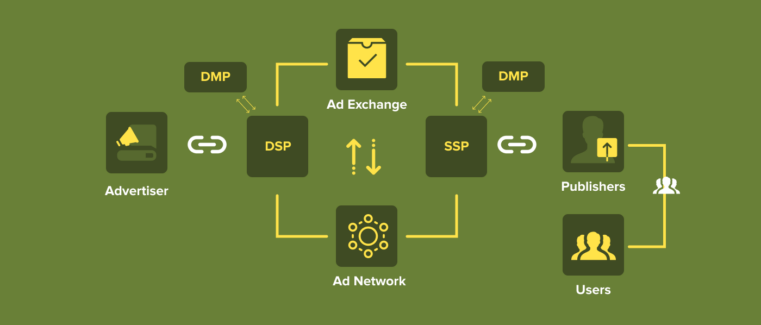
Here’s a breakdown of how programmatic advertising works:
• Programmatic ad buying kicks in whenever a user clicks on a publisher’s website.
• The publisher initiates an auction for the ad impression via supply-side platforms.
• The advertisers place bids on behalf of the advertisers based on campaign parameters, like demographics and budget, via demand-side platforms.
• The winning bidder, typically the advertiser with the highest cost per mille (CPM), is automatically awarded the ad space by the publisher.
• The ad appears on the website immediately for the user to see and engage with.
Throughout the process, functionalities of both DSPs and SSPs are aided by DMPs.
Programmatic Advertising Key Terms
Let’s define top programmatic advertising terms.
Supply-Side Platforms
Supply-side platforms (SSPs), also known as sell-side platforms – are used by publishers to list and monetize their ad inventory and make it programmatically accessible via ad exchanges. SSPs allow publishers to set their desired bidding range to maximize revenue.
Demand-Side Platforms
Demand-side platforms (DSPs) are used by advertisers, primarily marketers or agencies, to purchase digital ad space across multiple platforms. DSPs enable advertisers to set certain campaign parameters.
Data-Management Platforms
Data-management platforms (DMPs) are independent platforms that aggregate first-, second- and third-party audience data from various sources to create detailed yet anonymized customer profiles.
Publishers and advertisers alike rely on DMPs to understand their audience better and refine their ad targeting.
Ad Exchange
The ad exchange is the point at which ad space sellers and buyers engage in real-time bidding (RTB), essentially functioning as a digital marketplace.
Programmatic Advertising in Action
To further demystify how programmatic advertising works, let’s look at a hypothetical case of RTB programmatic advertising:
Picture a tech enthusiast named John looking to read the latest tech news from his favorite outlet.
Unbeknownst to John, as he loads the webpage with a dedicated ad space, a ton of behind-the-scenes activity takes place.
The ad exchange is triggered.
The SSP, armed with John’s user information via a DMP, sends this ad request to DSPs. Now, a brand using a DSP has already set up its campaign details and target market also with the help of its respective DMP.
If John matches the criteria, the DSP submits a bid to the ad exchange in real time.
The ad exchange then validates the bid, along with other bids, checks for malware and selects the winning bid.
Once chosen, the winning ad is displayed on the webpage, where John can now choose to engage with both the publisher’s content and the ad.
Quite the intricate virtual dance, isn’t it?
But all it takes is just 100 milliseconds to complete the bidding.
Benefits of Programmatic Advertising: Why Programmatic Advertising Gets Results
Many businesses, particularly advertisers, are turning to programmatic advertising for these benefits:
• Large-scale yet targeted audience reach
• Amplified retargeting
• Segmented first and third-party data
• Heightened advertising efficiency
• Flexible ad-buying options
• Completely measurable results
More about these benefits of programmatic advertising:
Large-Scale Yet Targeted Audience Reach
Perhaps the top benefit of programmatic advertising is its powerful targeting capability, making it the preferred method for reaching a broad audience through extensive cross-platform inventory.
Some of the targeting available in programmatic advertising include the following:
• Demographic targeting is based on data like age, gender, education level or profession.
• Behavioral targeting focuses on consumer behavior like browsing or shopping history.
• Location targeting allows you to target at a country, state, city or even zip code level.
• Contextual targeting means targeting web pages or apps that are contextually relevant.
• Device targeting is based on different user devices like mobile phones, desktops or tablets.
• Weather targeting allows you to target audiences in the right weather conditions.
• Retargeting is how you re-engage previous users who have previously shown interest.
Amplified Retargeting
With its use of AI and machine learning, programmatic advertising bolsters the effectiveness of retargeting campaigns. Programmatic advertising’s personalized and timely ads not only reinforce brand awareness but also increase the likelihood of conversion as users move through the sales funnel.
To further maximize retargeting impact, advertisers must present compelling creative content that captures the attention of website visitors and entices them to revisit the site or app.
Segmented First and Third-Party Data
Programmatic advertising offers diverse audience data segments for advertisers. You can securely upload their owned first-party data, targeting specific individuals through real-time bidding signals. DSPs boast various third-party segments for you to capitalize on.
Combining first and third-party data provides a nuanced audience understanding. Such targeting options allow for a broader, potentially untapped audience. Both contribute to campaign optimization, guiding decisions on creatives, placements and bidding strategies.
Heightened Advertising Efficiency
Programmatic marketing simplifies and automates ad buying across multiple channels while eliminating guesswork with data-driven decisions. This way, marketers can concentrate on other essential tasks like understanding their audience, crafting compelling ad copy and devising future campaign strategies.
Per Google News Initiative, the cost per mile or thousand impressions in programmatic advertising is between $1-5.
Flexible Ad-Buying Options
Regardless of whether your business is a small to medium-sized enterprise or a larger corporation, programmatic advertising empowers you to develop ads within any marketing budget.
Programmatic platforms permit you to establish your maximum budget, ensuring your ads never exceed the allocated amount while still creating impactful ads that reach the right target audience.
Completely Measurable Results
Programmatic advertising provides a high level of transparency and measurability. Real-time analytics allow you to track the performance of your campaigns, measure key metrics and make data-driven decisions promptly.
On top of key performance indicators (KPIs) or metrics like impressions, clicks, conversions and ROAS, you can see which platforms your programmatic ads appear in and the type of audience that interacts with your ad.
Types of Programmatic Media Buying (Programmatic Deals)
Real-time bidding is the most popular of the four types of programmatic advertising. For insights into how ad inventory can be, here are the different programmatic deals at a glance:
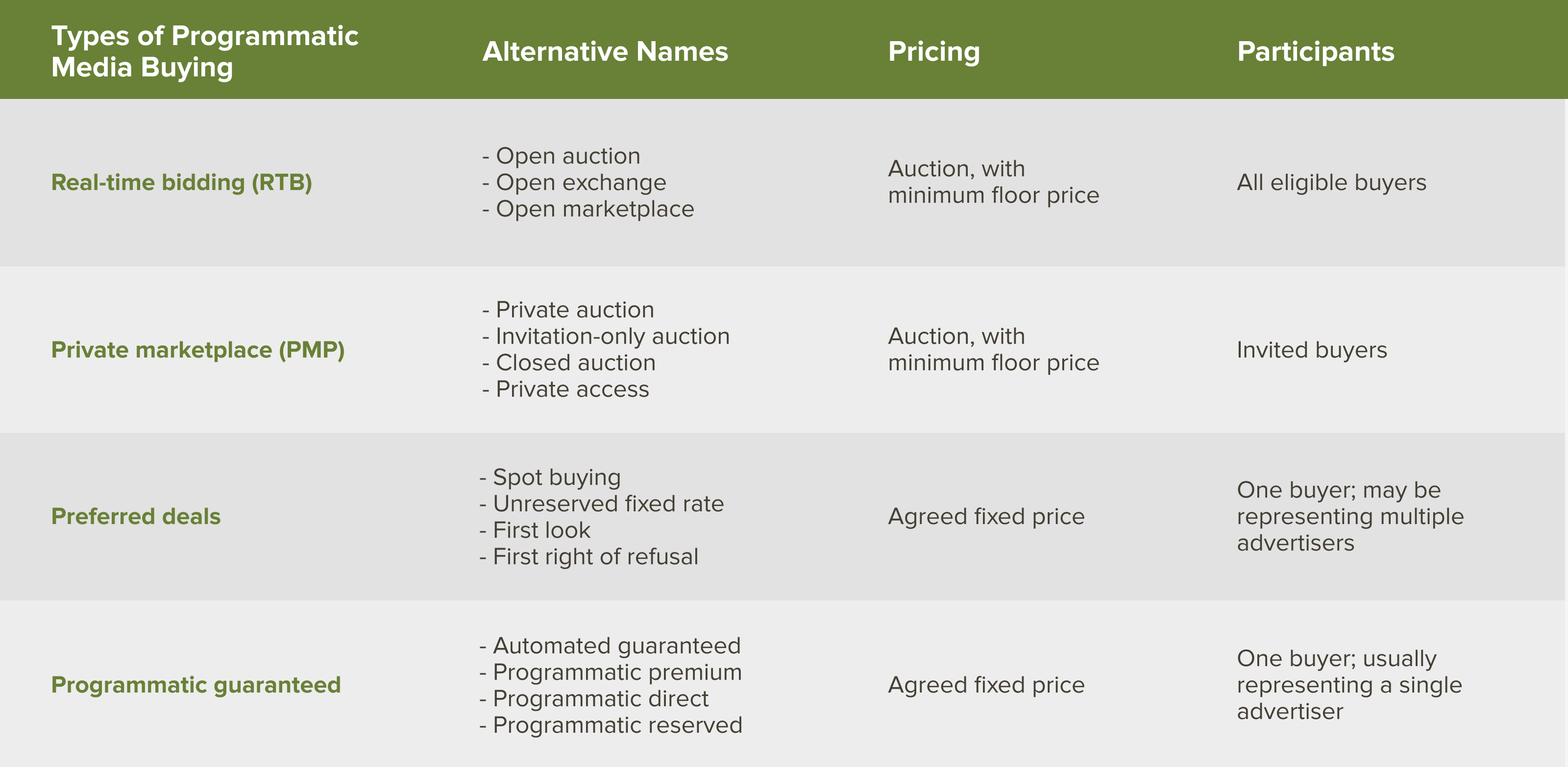
Let’s look at the four types of programmatic advertising more closely:
Real-Time Bidding
In RTB, advertising placements are sold through an open auction. Unlike traditional auctions, where the winner may be charged their highest bid amount, the winning bidder is only billed a nominal amount ($0.01) above the second-highest bidder for the ad spot in RTB.
Despite the popularity of open auctions or RTB in programmatic advertising, there’s a catch, especially for those without guidance from a programmatic advertising agency. Advertisers might not have complete control over where their ads end up, risking unintended placements.
Private Marketplace
PMP or private auction enables publishers as big as The Wall Street Journal, The New York Times, and Forbes to reserve their premium ad spots for shortlisted advertisers. Publishers may restrict impressions to first-party user lists only or a specific content type.
PMP’s exclusive nature sets it apart from the openness of RTB. By permitting only trusted, pre-approved advertisers, this method ensures a secure and transparent approach to media selling. What’s more, advertisers always know where their ads will appear.
Preferred Deals
Preferred deals or spot buying involve the buyer and publishers negotiating pricing, targeting, and other specifics for an ad inventory the buyer may purchase. The buyer gets a “first look” or “preferred” chance to bid at the agreed price during ad requests.
Also known as unreserved fixed rate deals, such deals are non-guaranteed as the negotiated inventory isn’t exclusively reserved for the buyer; they are not bound to follow through with the purchase. If no buyers acquire the inventory, it goes to open or market auction.
Programmatic Guaranteed
Programmatic or automated guaranteed, favored by advertisers with precise ad placement requirements and flexible budgets, allows direct one-on-one negotiations without bidding. Advertisers gain control over ad inventories, pricing, audience targeting and frequency capping.
In programmatic guaranteed, publishers and advertisers directly negotiate terms, with publishers committing to selling a fixed number of impressions at a set price. Despite the absence of an auction, programmatic guaranteed is recognized as a highly cost-effective method of media selling.
Common Programmatic Ad Formats
While all digital ads can be programmatically purchased. The most common programmatic ad formats are:
• Display ads
• Video ads
• Connected TV ads
• Audio ads
• Digital out-of-home ads
Here’s more about the different types of ads that programmatic advertising experts typically run:
Display Ads
Display ads are found in headers, footers or sidebars and take forms such as static images, videos or interactive multimedia content. Examples of display ads are:
• Static and animated ads
• Rich media
• Sticky ads
• Dynamic ads
• Floating ads
• Calculator ads
• Data collection banners
Video Ads
As video consumption rises, advertisers increasingly capitalize on this programmatic ad type, which can be either in-stream, outstream or in-feed.
• In-stream video ads appear before a viewer watches a video or interrupts the content along the way, delivered within the video player.
• Outstream video ads may be delivered as a banner, in the middle of an article or any corner of a webpage; they can be served as a pop-up.
• In-feed video ads position your brand alongside relevant YouTube content, appearing in search results, watch next and the YouTube app Home feed.
Connected TV Ads
Connected TV entails streaming premium content through apps on either a smart TV or an over-the-top device.
Programmatic CTV ads are a form of targeted advertising delivered through internet-connected television sets or devices, such as smart TVs, streaming devices or gaming consoles.
Advertisements can be presented before the content starts or during traditional commercial breaks.
Audio Ads
Audio or voice ads are found on platforms like podcasts, digital radio, and music streaming services such as BBC Sounds, Spotify, Apple Music, Pandora, and Amazon Music.
Programmatic audio ads can be targeted based on listening history, much like regular display ads, allowing advertisers to deliver personalized messages to engaged audiences in a less intrusive manner.
Digital Out-of-Home Ads
Digital out-of-home (DOOH) ads are served through dynamic signages or billboards in public or commercial spaces. Some examples of where programmatic DOOH ads may appear include digital billboards found in:
• High-traffic areas like highways or busy intersections
• Transit stations like bus stops, subway stations or airports
• Shopping malls and specific stores
• Healthcare facilities’ lobbies and clinics
• Hotel rooms, lobbies or elevators
Top Demand-Side Platform Examples
Advertisers use demand-side platforms, as mentioned above. Here are the top DSP examples:
Display & Video 360
Display & Video 360 (DV360) is the DSP leg of the Google Marketing Platform. Given that it’s a Google product, you can be certain of driving real impressions. It opens doors to Google’s extensive network and taps into significant third-party networks.
Adobe Advertising Cloud
Adobe Advertising Cloud’s unique feature is its seamless integration with Adobe Analytics. This integration aids in-depth analysis of targeting strategies, covering ad creative impact on paid media and broader insights into on-site performance.
OneView by Roku
OneView is crafted for TV-first streaming inventory and data. Using Roku’s direct consumer relationships, segmented audience and third-party vendors, OneView acts as a unified platform to streamline advertising across TV, desktop and mobile.
Amazon DSP
Amazon DSP streamlines display, video and audio ad acquisition across a wide network of publishers, enabling you to reach users on and off Amazon. While known as the eCommerce giant, you don’t have to sell anything on Amazon to get access.
Yahoo DSP
Yahoo DSP, previously Verizon Media DSP, provides access to premium and exclusive ad inventory. The dynamic platform and its top apps, such as Yahoo Sports, Yahoo Finance, Yahoo Fantasy and Yahoo Mail, unite brands and publishers with avid fans.
Top Supply-Side Platform Examples
Supply-side platforms are used by publishers, as said earlier. Here are the top SSP examples:
Google Ad Manager
Google Ad Manager is a complete ad platform featuring an SSP and ad server. Publishers and brands can access Google AdX for premium exchanges. The platform supports the monetization of ad inventory across display, video and rich media ad formats.
OpenX
OpenX pioneered header bidding, a technique where publishers offer their inventory to multiple ad exchanges before requesting ad servers. With header bidding, publishers can auction inventory simultaneously, selling on a per-impression basis.
PubMatic
PubMatic’s ad quality tools and processes ensure the safety of your inventory and uphold user experience standards with measurable quality. This platform is trusted by publishers such as Business Insider, BBC World Service, ABC and The Guardian.
Xandr
Xandr, formerly AppNexus, is a platform acquired by Microsoft. With its header bidding, deals capabilities and curated premium demand, Xandr empowers advanced demand management across all formats – from display to CTV to native.
Magnite
Magnite emerged from the Rubicon Project and Telaria merger in 2020, aiming to form the world’s largest independent SSP. The platform specializes in video monetization and is trusted by leading brands like Warner Bros. Discovery and Samsung.
Programmatic Advertising Frequently Asked Questions
Cuyler Franzke, Thrive’s in-house programmatic advertising expert, shares his expertise by addressing frequently asked questions about programmatic advertising.
| Programmatic Advertising FAQs | |
| Q. | Does Programmatic Advertising Work for Niche Markets? |
| A. | Yes, every strategy can include programmatic; there is just a wide variance of effectiveness based on your audience.
The two main factors to determine if programmatic is a good fit for your market are the size of your audience and the volume of web traffic. If your audience is small and unengaged at the top of the funnel, programmatic may yield minimal results. Lower web traffic also makes retargeting less effective. The key is to use programmatic advertising as a supplemental strategy. |
| Q. | Can Programmatic Advertising Be Effective Without a Large Marketing Budget? |
| A. | Yes, any marketing budget can work as long as it is a healthy proportion of the impressions available.
A budget as low as $500 a month can drive results. If we are driving awareness, the larger the budget, the better, but we can narrow the audience down to increase our impression share and effectiveness. With retargeting, a smaller budget goes a long way since it is based on web traffic. |
| Q. | How Can I Combat Programmatic Ad Fraud? |
| A. | Find a top-tier DSP with direct relationships with ad networks. Or, if your budget allows, work directly with the network. Most DSP companies will have fraud protection in layers, such as the vetting of websites within the network, blacklisting capabilities and AI and machine learning to actively work to remove and avoid fraudulence.
A good DSP will actively and automatically optimize around your true audience and adapt if ad fraud occurs. Tapping the expertise of a programmatic advertising agency is also a wise approach. |
| Q. | What’s the Future of Programmatic Advertising? |
| A. | Omni-channel. With platforms across paid media becoming increasingly driven by AI and machine learning, self-serve platforms will continue to be consolidated to the point where all of your paid media can be managed from a single platform.
With omni-channel programmatic, you will be able to pick your audiences and KPIs and allow the AI to run campaigns for you across all platforms. The important thing now is to think about how programmatic fits into your marketing stack and its purpose to your overall strategy. |
For more programmatic advertising questions, send us a message.
Explore a New Revenue Stream With a Programmatic Advertising Agency
If you’re ready to make a profit with programmatic advertising, Thrive is here to help you get started.
But, just exactly how?
“Thrive will start with the goals of your business. From there, we will determine if and how programmatic fits with the defined goals, budget, audience and overall strategy,” Franzke said.
“If it is determined that programmatic advertising should be included in your strategy, we will utilize the top DSPs and ad networks to deploy a highly comprehensive campaign to reach toward your KPIs.”
With full transparency, The Paid Media Team at Thrive will be a resource to the world of programmatic, shedding light on its mysteries and shadows and opening the box of lucrative opportunities, Franzke noted.
We also offer pay-per-click (PPC) advertising services.
Talk to our team – take the first step to programmatic advertising!

